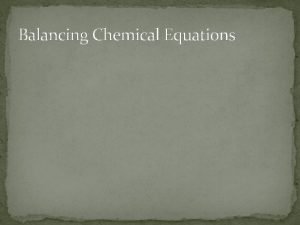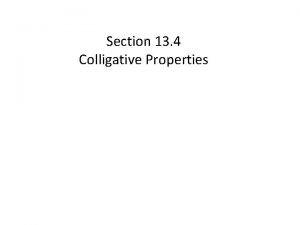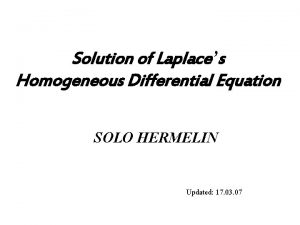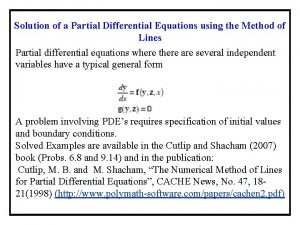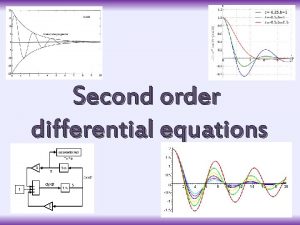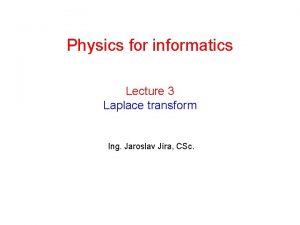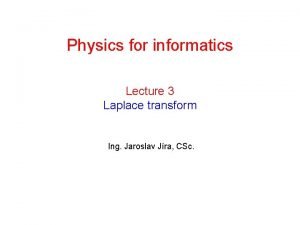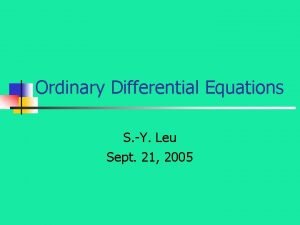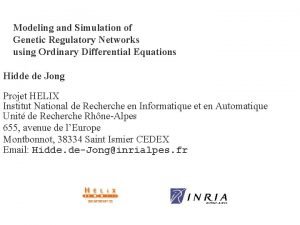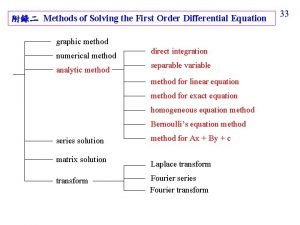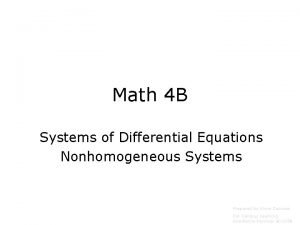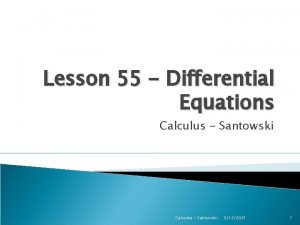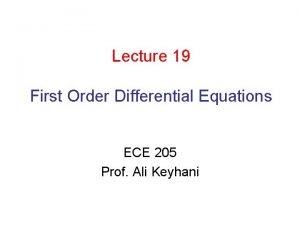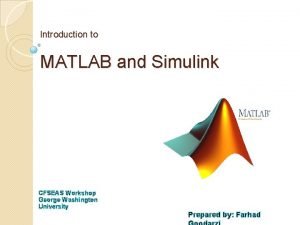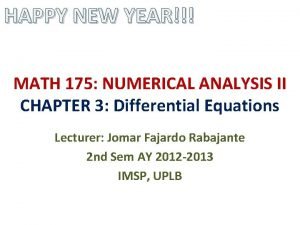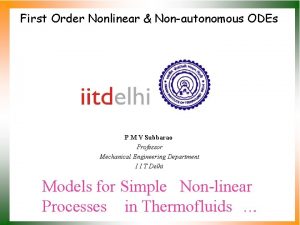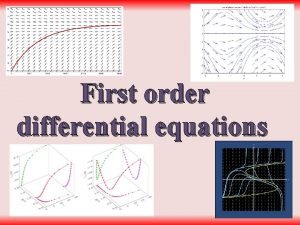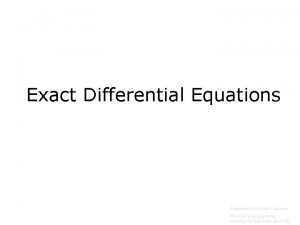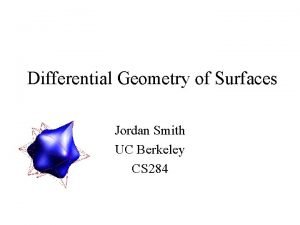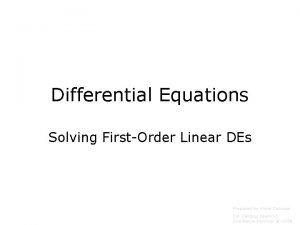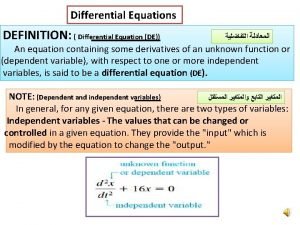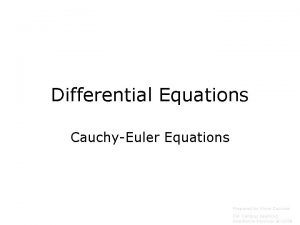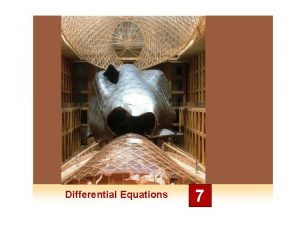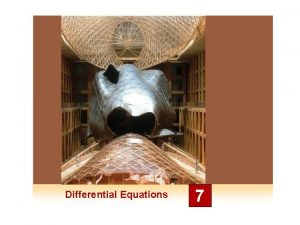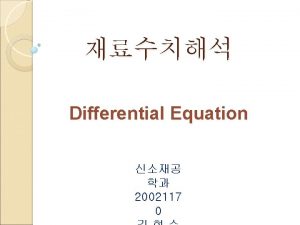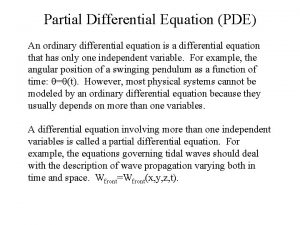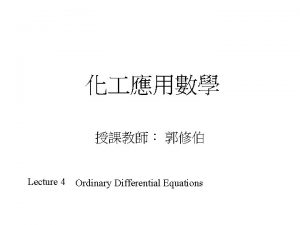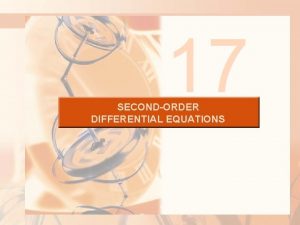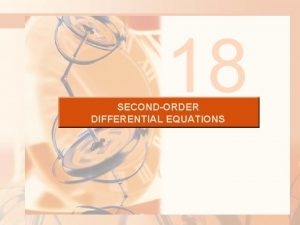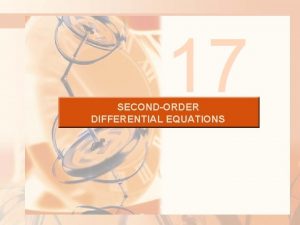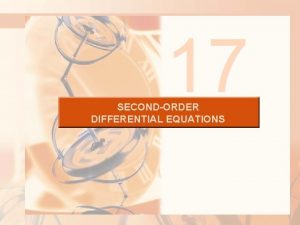DIFFERENTIAL EQUATIONS Differential Equations An equation which involves







































- Slides: 39

DIFFERENTIAL EQUATIONS

Differential Equations ð An equation which involves unknown function and its derivatives Ø ordinary differential equation (ode) : not involve partial derivatives Ø partial differential equation (pde) : involves partial derivatives Ø order of the differential equation is the order of the highest derivatives Example s: second order ordinary differential equation first order partial differential equation

Differential Equations Modeling Equations Note that via the Differential set of equations is called a Model for the system. How do we build a Model? The basic steps in building a model are: Step 1: Clearly state the assumptions on which the model will be based. These assumptions should describe the relationships among the quantities to be studied. Step 2: Completely describe the parameters and variables to be used in the model. Step 3: Use the assumptions (from Step 1) to derive mathematical equations relating the parameters and variables (from Step 2).

Differential Equations Some Application of Differential Equation in Engin

Differential Equations Larutan Air-Garam Awal: Vol. air : Vo liter Massa garam : a gram Konsentrasi garam : b gram/ Laju alir : e liter/min ? Tercampur sempurna laju alir : f liter/min Massa garam setiap saat (menit) ?

Differential Equations ð A linear differential equation of order n is a differential equation written in the following form: where an(x) is not the zero function ð General solution : looking for the unknown function of a differential equation ð Particular solution (Initial Value Problem) : looking for the unknown function of a differential equation where the values of the unknown function and its derivatives at some point are known

1 st Order DE - Separable Equations The differential equation M(x, y)dx + N(x, y)dy = 0 is separable if the equation can be written in the form: Solutio n 1. : Multiply the equation by integrating factor: 2. The variable are separated : 3. Integrating to find the solution:

1 st Order DE - Separable Equations Example s: 1. Solve : Answer:

1 st Order DE - Separable Equations Example s: 1. Solve : Answer:

1 st Order DE - Separable Equations Example s: 2. Find the particular solution of : Answer:

1 st Order DE - Homogeneous Equations Homogeneous Function f (x, y) is called homogenous of degree n if : Example s: homogeneous of degree 4 nonhomogeneous

1 st Order DE - Homogeneous Equations The differential equation M(x, y)dx + N(x, y)dy = 0 is homogeneous if M(x, y) and N(x, y) are homogeneous and of the same degree Solutio n 1. : Use the transformation to : 2. The equation become separable equation: 3. Use solution method for separable equation 4. After integrating, v is replaced by y/x

1 st Order DE – Homogeneous Equations Example s: 1. Solve : Answer:

1 st Order DE - Homogeneous Equations Example s: 2. Solve : Answer:

1 st Order DE – Exact Equation The differential equation M(x, y)dx + N(x, y)dy = 0 is an exact equation if : The solutions are given by the implicit equation where : F/ x = M(x, y) and F/ y = N(x, y) Solutio 1. : Integrate either M(x, y) with respect to x or n N(x, y) to y. Assume integrating M(x, y), then : 2. Now : or :

1 st Order DE – Exact Equation 3. Integrate ’(y) to get (y) and write down the result F(x, y) = C Example s: 1. Solve : Answer:

1 st Order DE – Exact Equation Example s: 2. Solve : Answer:

1 st Order DE – Non Exact Equation The differential equation M(x, y)dx + N(x, y)dy = 0 is a non exact equation if : The solutions are given by using integrating factor to change the equation into exact equation Solutio n : Check if 1. : then integrating factor is or if : then integrating factor is

1 st Order DE – Non Exact Equation 2. Multiply the differential equation with integrating factor which result an exact equationusing procedure for an exact 3. differential Solve the equation

1 st Order DE – Non Exact Equation Example s: 1. Solve : Answer:

1 st Order DE – Non Exact Equation Example s: 2. Solve : Answer:

1 st Order DE – Linear Equation A first order linear differential equation has the following general form: Solutio n 1. : Find the integrating factor: 2. Evaluate : 3. Find the solution:

1 st Order DE – Linear Equation Example s: 1. Solve : Answer:

1 st Order DE – Linear Equation Example s: 2. Find the particular solution of : Answer:

2 nd Order DE – Linear Equation A second order differential equation is an equation involving the unknown function y, its derivatives y' and y'', and the variable x. We will consider explicit differential equations of the form : A linear second order differential equations is writte When d(x) = 0, the equation is called homogeneous, otherwise it is called nonhomogeneous

2 nd Order DE – Linear Equation To a nonhomogeneous equation (NH) we associate the so called associated homogeneous (H) Main result: The general solution to the equation (NH) is given by: where: (i) yh is the general solution to the associated homogeneous equation (H); (ii) yp is a particular solution to the equation (NH).

2 nd Order DE – Linear Equation Basic property Consider the homogeneous second order linear equa or the explicit one Property: If y 1 and y 2 are two solutions, then: is also a solution for any arbitrary constants c 1 ,

2 nd Order DE – Reduction of Order Technique This technique is very important since it helps one to find a second solution independent from a known one. Let y 1 be a non-zero solution of: Then, a second solution y 2 independent of y 1 can b Where: The general solution is then given by

2 nd Order DE – Reduction of Order Example s: Find the general solution to the Legendre equation 1. Using the fact that : y 1 = x is a solution.

2 nd Order DE – Homogeneous LE with Constant Coefficients Homogeneous Linear Equations with Constant Coe A second order homogeneous equation with constant coefficients is written as: where a, b and c are constant The steps to follow in order to find the general soluti (1) Write down the characteristic equation This is a quadratic. Let 1 and 2 be its roots we ha

2 nd Order DE – Homogeneous LE with Constant Coefficients (2) If 1 and 2 are distinct real numbers (if b 2 - 4 ac > 0), then the general solution is: (3) If 1 = 2 (if b 2 - 4 ac = 0), then the general solution is: (4) If 1 and 2 are complex numbers (if b 2 - 4 ac < 0), then the general solution is: Where:

2 nd Order DE – Homogeneous LE with Constant Coefficients 1. Find the solution to the Initial Value Problem

2 nd Order DE – Non Homogeneous LE To a nonhomogeneous equation (NH) we associate the so called associated homogeneous (H) Main result: The general solution to the equation (NH) is given by: where: (i) yh is the general solution to the associated homogeneous equation (H); (ii) yp is a particular solution to the equation (NH).

2 nd Order DE – Non Homogeneous LE Method Undetermined Coefficients We will guess the form of yp and then plug it in the equation to find it. However, it works only under the following two conditions: q the associated homogeneous equations has consta q the nonhomogeneous term d(x) is a special form where Pn(x) and Ln(x) are polynomial functions of d Note: we may assume that d(x) is a sum of such functions Then a particular solution yp is given by: Where:

2 nd Order DE – Non Homogeneous LE Method Undetermined Coefficients The steps to follow in applying this method: 1. Check that the two conditions are satisfied 2. Write down the characteristic equation and find its 3. Write down the number 4. Compare this number to the roots of the character If : 5. Write down the form of particular solution Where: 6. Find constant A and B by plugging yp solution to o

2 nd Order DE – Non Homogeneous LE Method Undetermined Coefficients 1. Find a particular solution to the equation

2 nd Order DE – Non Homogeneous LE Method Undetermined Coefficients If the nonhomogeneous term d(x) consist of several We split the original equation into N equations Then find a particular solution ypi A particular solution to the original equation is given

2 nd Order DE – Non Homogeneous LE Method Undetermined Coefficients If the nonhomogeneous term d(x) consist of several We split the original equation into N equations Then find a particular solution ypi A particular solution to the original equation is given

2 nd Order DE – Non Homogeneous LE Method Undetermined Coefficients 1. Find a particular solution to the equation
 Euler's equation of motion in fluid mechanics
Euler's equation of motion in fluid mechanics Ode pde
Ode pde Bernoulli differential equation
Bernoulli differential equation Balancing an equation involves adjusting
Balancing an equation involves adjusting Balancing an equation involves adjusting
Balancing an equation involves adjusting Balancing equations chart
Balancing equations chart Simile figure of speech example
Simile figure of speech example Retained earnings for sole proprietorship
Retained earnings for sole proprietorship Unit 4 success
Unit 4 success Viewpoint composition photography
Viewpoint composition photography Vapor pressure lowering
Vapor pressure lowering Stealing a speech entirely from a single person is
Stealing a speech entirely from a single person is Slidetodoc.com
Slidetodoc.com Solo hermelin
Solo hermelin Pde solutions
Pde solutions 2nd order homogeneous differential equation
2nd order homogeneous differential equation Laplace transform formula
Laplace transform formula Laplace transform differential equation
Laplace transform differential equation Linear differential equation
Linear differential equation Differential equation basics
Differential equation basics Differential equation exponential solution
Differential equation exponential solution Piecewise differential equation
Piecewise differential equation First order differential equation
First order differential equation Find the general solution of the differential equation
Find the general solution of the differential equation Calculus equations
Calculus equations Rc circuit differential equation
Rc circuit differential equation Dot product matlab
Dot product matlab Examples of differential equation
Examples of differential equation Definition of homogeneous differential equation
Definition of homogeneous differential equation Happy new year math formula
Happy new year math formula Non autonomous differential equation
Non autonomous differential equation First order ode
First order ode Exact differential equation
Exact differential equation Weingarten equation in differential geometry
Weingarten equation in differential geometry Solution to it
Solution to it Growth and decay differential equation
Growth and decay differential equation Classification of pde examples
Classification of pde examples Cauchy euler differential equation
Cauchy euler differential equation Logistic equation
Logistic equation Euler's differential equation
Euler's differential equation




